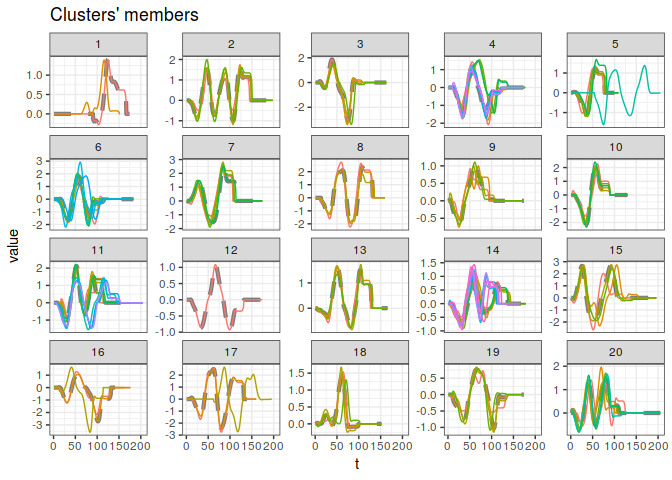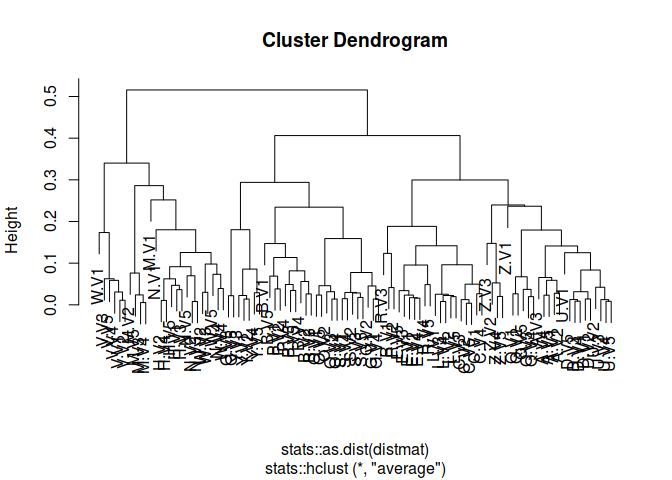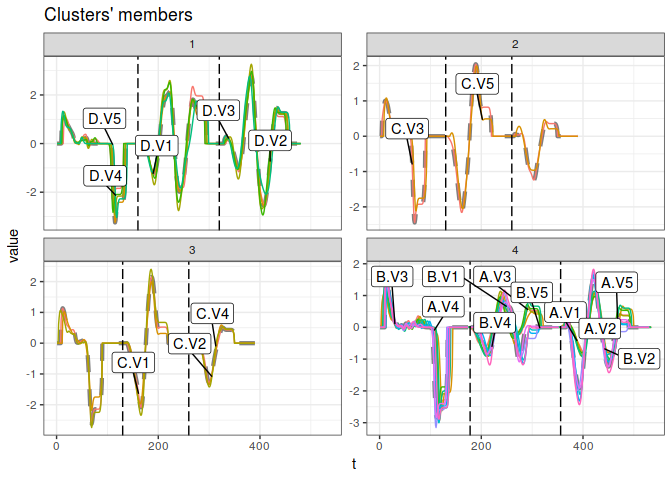asardaes / Dtwclust
Programming Languages
Labels
Projects that are alternatives of or similar to Dtwclust
Time Series Clustering Along with Optimizations for the Dynamic Time Warping (DTW) Distance
Time series clustering with a wide variety of strategies and a series of optimizations specific to the Dynamic Time Warping (DTW) distance and its corresponding lower bounds (LBs). There are implementations of both traditional clustering algorithms, and more recent procedures such as k-Shape and TADPole clustering. Functionality can be easily extended with custom distance measures and centroid definitions.
Many of the algorithms implemented in this package are specifically tailored to DTW, hence its name. However, the main clustering function is flexible so that one can test many different clustering approaches, using either the time series directly, or by applying suitable transformations and then clustering in the resulting space. Other implementations included in the package provide some alternatives to DTW.
For more information:
- Vignette with theory (with examples in the appendices)
- Timing experiments
- Parallelization considerations
- Functions’ documentation
- Sample shiny app
- CRAN’s time series view
Implementations
- Partitional, hierarchical and fuzzy clustering
- k-Shape clustering
- Shape-based distance
- Shape extraction for time series
- TADPole clustering
- k-Shape clustering
- An optimized version of DTW
- Keogh’s and Lemire’s DTW lower bounds
- Global alignment kernel (GAK) distance
- DTW Barycenter Averaging
- Soft-DTW (distance and centroid)
- Some multivariate support (GAK, DTW and soft-DTW)
- Cluster validity indices (crisp and fuzzy, internal and external)
- Parallelization for most functions
Installation
The latest version from CRAN can be installed with
install.packages("dtwclust").
If you want to test the latest version from github, first install the
prerequisites for R package
development
(LaTeX is only necessary if you want to build the vignette) as well as
the remotes package, and
then type remotes::install_github("asardaes/dtwclust").
If you’re wondering about which version to install, take a look at the CHANGELOG file, I try to keep it updated. Check the Unix and Windows continuous integration builds to make sure everything is working, but do note that they tend to fail for reasons unrelated to the package’s functionality.
License
GNU General Public License v3.0. See license and copyrights.
This software package was developed independently of any organization or institution that is or has been associated with the author.
Examples
# Load series
data("uciCT")
Partitional
pc <- tsclust(CharTraj, type = "partitional", k = 20L,
distance = "dtw_basic", centroid = "pam",
seed = 3247L, trace = TRUE,
args = tsclust_args(dist = list(window.size = 20L)))
#>
#> Precomputing distance matrix...
#>
#> Iteration 1: Changes / Distsum = 100 / 1361.256
#> Iteration 2: Changes / Distsum = 8 / 1101.633
#> Iteration 3: Changes / Distsum = 2 / 1036.096
#> Iteration 4: Changes / Distsum = 0 / 1031.353
#>
#> Elapsed time is 0.412 seconds.
plot(pc)
Hierarchical
hc <- tsclust(CharTraj, type = "hierarchical", k = 20L,
distance = "sbd", trace = TRUE,
control = hierarchical_control(method = "average"))
#>
#> Calculating distance matrix...
#> Performing hierarchical clustering...
#> Extracting centroids...
#>
#> Elapsed time is 0.147 seconds.
plot(hc)
Fuzzy
# Calculate autocorrelation up to 50th lag, considering a list of time series as input
acf_fun <- function(series, ...) {
lapply(series, function(x) { as.numeric(acf(x, lag.max = 50L, plot = FALSE)$acf) })
}
# Autocorrelation-based fuzzy c-means
fc <- tsclust(CharTraj[1L:25L], type = "fuzzy", k = 5L,
preproc = acf_fun, distance = "L2",
seed = 123L)
fc
#> fuzzy clustering with 5 clusters
#> Using l2 distance
#> Using fcm centroids
#> Using acf_fun preprocessing
#>
#> Time required for analysis:
#> user system elapsed
#> 0.03 0.00 0.03
#>
#> Head of fuzzy memberships:
#>
#> cluster_1 cluster_2 cluster_3 cluster_4 cluster_5
#> A.V1 0.04550608 0.015278671 0.06017278 0.02854909 0.8504934
#> A.V2 0.02649930 0.007304681 0.03576385 0.01482575 0.9156064
#> A.V3 0.03891669 0.007107856 0.03584082 0.01348798 0.9046467
#> A.V4 0.09316283 0.194096301 0.10463724 0.20029868 0.4078050
#> A.V5 0.09423895 0.163296699 0.11727901 0.17605511 0.4491302
#> B.V1 0.39131228 0.034768969 0.35717141 0.07915848 0.1375889
Some multivariate support
# Multivariate series provided as a list of matrices, using GAK distance
mvc <- tsclust(CharTrajMV[1L:20L], k = 4L, distance = "gak", seed = 390L)
# Note how the variables of each series are appended one after the other in the plot
plot(mvc, labels = list(nudge_x = -10, nudge_y = 1))



